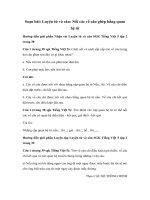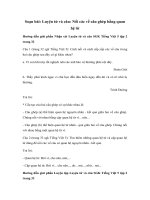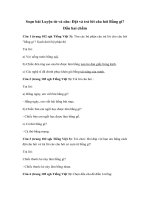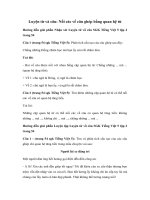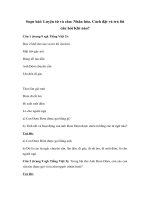- Trang chủ >>
- Khoa học xã hội >>
- Báo chí
Tải Unit 4 lớp 8 Skills 2 - Tiếng Anh 8 Unit 4 Our customs and traditions | Giải bài tập SGK tiếng Anh 8 mới Unit 4 Skills 2
Bạn đang xem bản rút gọn của tài liệu. Xem và tải ngay bản đầy đủ của tài liệu tại đây (88.18 KB, 5 trang )
<span class='text_page_counter'>(1)</span><div class='page_container' data-page=1>
<b>SOẠN TIẾNG ANH LỚP 8 MỚI THEO TỪNG UNIT</b>
<b>UNIT 4: OUR CUSTOMS AND TRADITIONS - SKILLS 2</b>
<b>I. Mục tiêu bài học</b>
<b>1. Aims:</b>
By the end of this lesson, students can
– Listen to get specific information about a traditional dance of an ethnic group in Viet
Nam.
– Write a description of a traditional Japanese.
<b>2. Objectives:</b>
- Vocabulary: the lexical items related to the topic “Our customs and traditions”.
<b>II. Soạn giải tiếng Anh lớp 8 Unit 4 Skills 2</b>
<b>Listening</b>
<b>1. Nhìn vào hình. Bạn nghĩ đây là truyền thống nào? Chia sẻ</b>
<b>những ý kiến của em với bạn học.</b>
Gợi ý: Xoe dance
<b>2. Listen to Mai’s presentation and complete the table with no</b>
<b>more than three words from the recording. Nghe bài thuyết</b>
<b>trình của Mai và hồn thành bảng sau với khơng quá 3 từ từ bài</b>
<b>nghe.</b>
</div>
<span class='text_page_counter'>(2)</span><div class='page_container' data-page=2>
<b>Đáp án</b>
(1) happy and wealthy
(2) private gatherings
(3) 30
(4) (the circle dance)
(5) social
(6) fire
(7) the music
(8) culture and lifestyle
<b>3. Listen again and tick ( √ ) true (T) or false (F). Nghe lại và √</b>
<b>đúng hoặc sai.</b>
<b>Bài nghe</b>
<b>Đáp án</b>
1 - T; 2 - F; 3 - F; 4 - T; 5 - T;
<b>Nội dung bài nghe</b>
Today I’m going to tell you about the xoe dance, a traditional dance of the Thai ethnic
group in VietNam. Thai people have followed this spiritual tradition for generations.
</div>
<span class='text_page_counter'>(3)</span><div class='page_container' data-page=3>
The xoe dance has more than 30 forms based on the first six ancient forms. The most
popular form is the xoe vong or ‘circle dance’ because it expresses social unity. People,
young or old alike, join hands to make a circle around the fire and dance to the music.
Besides the circle dance, there are dances with conical hats, paper fans or scarves.
Old people say they shouldn’t break with this tradition because it reflects Thai culture and
lifestyle. As a Thai folk song goes, without the xoe dance, the rice won’t grow and people
won’t get married.
<b>Hướng dẫn dịch</b>
Hôm nay tôi sẽ kể cho bạn nghe về điệu múa xòe, điệu nhảy truyền thống của dân tộc Thái
tại Việt Nam. Người Thái đã theo truyền thống tâm linh này qua nhiều thế hệ.
Các điệu múa xòe thể hiện cuộc sống và mong muốn làm việc của mọi người cho một cuộc
sống hạnh phúc và giàu có. Nó được thực hiện trong cả các cuộc tụ tập công cộng và tư
nhân như lễ kỷ niệm, lễ hội hoặc đồn tụ gia đình.
Múa xịe có hơn 30 hình thức dựa trên sáu hình thức cổ xưa. Các hình thức phổ biến nhất là
xịe vịng hoặc 'nhảy vịng trịn' vì nó thể hiện sự bình đẳng xã hội. Mọi người, trẻ hay già,
cùng chung tay tạo vòng tròn quanh ngọn lửa và nhảy theo âm nhạc. Bên cạnh các vịng
trịn , có những điệu múa với nón hình nón, người hâm mộ giấy hoặc chiếc khăn.
Người già nói rằng họ khơng nên phá vỡ truyền thống này bởi vì nó phản ánh văn hóa Thái
và lối sống. Như một bài hát dân gian Thái Lan, khơng có điệu múa xịe, cây lúa sẽ khơng
phát triển và mọi người sẽ không kết hôn.
<b>Writing</b>
</div>
<span class='text_page_counter'>(4)</span><div class='page_container' data-page=4>
<b>Gợi ý</b>
Obon dance is a traditional Japanese dance. The Obon dance used to express Japanese
people's honor their ancestors. The Obon dance is usually performed during the Obon
festival. The Obon festival takes place in August in many regions of Japan and in
mid-July in other regions. There are variety Obon forms in different regions. The most typical
form is circle dance. People make a circle around a yagura, which is a high wooden stage;
some dancers move clockwise, and some counter-clockwise. This is one of the most
important traditions. A lot of people come back to reunite with their families during the
Obon festival.
<b>5. Imagine that you are joining a writing contest about customs</b>
<b>and traditions and have chosen to write about the Obon dance.</b>
<b>Now write a description of this dance. Begin with the following</b>
<b>sentence. Tưởng tượng rằng em đang tham gia cuộc thi viết về</b>
<b>phong tục và truyền thống và chọn viết về điệu múa Obon. Bây</b>
<b>giờ hãy viết một đoạn miêu tả về điệu múa này. Bắt đầu bằng</b>
<b>câu sau đây.</b>
<b>Gợi ý</b>
There is a tradition in Japan that people perform the Obon dance during the Obon festival.
The festival happens in mid-August in many regions of Japan. Forms of Obon dance depend
on their regions. In order to perform it, people make a circle around a yagura, a high
wooden stage; some dancers move clockwise, and some counter-clockwise. I really like this
traditional dance.
</div>
<span class='text_page_counter'>(5)</span><div class='page_container' data-page=5>
<b>Em có thể tìm ra lỗi nào trong bài của bạn ấy không? Hãy chia</b>
<b>sẻ ý kiến của mình.</b>
Các em tự trao đổi bài cho nhau, tìm lỗi và tự nhận xét nhé.
Mời bạn đọc thêm tài liệu Tiếng Anh lớp 8 tại đây:
Bài tập Tiếng Anh lớp 8 theo từng Unit:
</div>
<!--links-->
